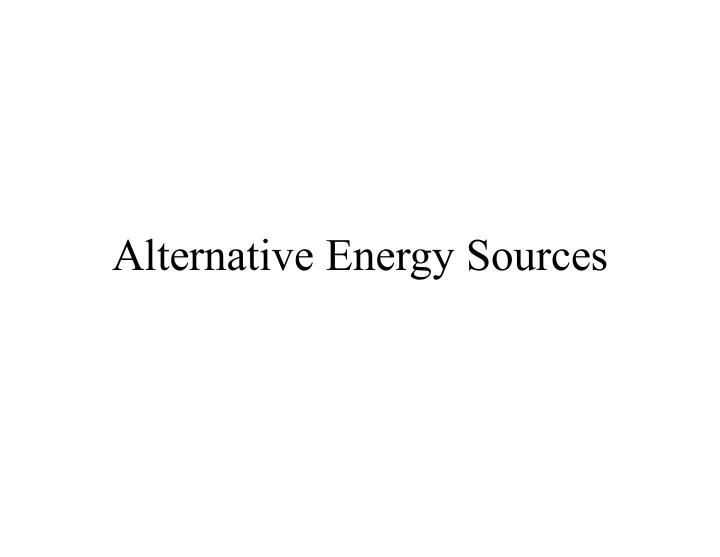

Alternative Energy Sources
How is your electricity generated? Steps to generating electricity: 1. Heat is created 2. The heat boils water, which creates steam 3. The steam builds pressure in pipes 4. The pressure turns turbine blades 5. When the turbines spin, so does a generator 6. When the generator spins, electricity is created 7. The steam cools back into water What is wrong with this?
How is your electricity generated? • Coal and natural gas make 67% of the electricity used in our country • TEP (Tucson Electric Power) stopped using coal toward the end of 2015 in favor of natural gas • There is a finite amount of coal, natural gas, and oil This leaves people with two choices: 1. Use less electricity as resources are depleted and accept that, eventually, there will not be any more fuel 2. Find other sources of energy so we can keep having electricity
Forms Of Alternative Energy • Nuclear • Photovoltaic (solar) • Wind • Hydropower • Biopower • Geothermal • Ocean
Nuclear Power 1. Heat is created by a nuclear reaction 2. The heat boils water, which creates steam 3. The steam builds pressure in pipes 4. The pressure turns turbine blades 5. When the turbines spin, so does a generator 6. When the generator spins, electricity is created 7. The steam cools back into water 19% of our nation’s energy comes from nuclear power
Nuclear Power – Pros and Cons Advantages Disadvantages Nuclear power costs about the same as coal, Although not much waste is produced, it is so it's not expensive to make. very, very dangerous. Does not produce smoke or carbon dioxide, The waste must be sealed up and buried for so it does not contribute to the greenhouse many years to allow the radioactivity to die effect. away. Produces huge amounts of energy from For all that time it must be kept safe from small amounts of fuel. earthquakes, flooding, terrorists and everything else. This is difficult. Produces small amounts of waste. Nuclear power is reliable, but a lot of money Nuclear power is reliable. has to be spent on safety - if it does go wrong, a nuclear accident can be catastrophic
Photovoltaic (Solar) Power 1. Sunlight trapped by glass 2. Electrons are bumped from one layer of silicon to another 3. Movement of electrons is called electricity .4% of our nation’s energy comes from solar power 5% of Arizona’s power comes from solar power
Solar Power – Pros and Cons Advantages Disadvantages Low maintenance cost High cost up front Does not produce smoke or carbon dioxide, Cloudy days, nights don’t produce much so it does not contribute to the greenhouse electricity effect. Panels are not very efficient (12% – 30%) No fuel needed Panels good for 25 years
Wind Power 4.4% of our nation’s energy comes from wind power 1. Wind blows over the blades, causing them to turn 2. They are connected to a shaft that turns a turbine 3. The turbine turns a generator 4. Electricity comes from the generator
Wind Power 2700 windmills in Palm Springs 65 ft tall Blades are 15 ft long
Wind – Pros and Cons Advantages Disadvantages Multiple windmills can be turned by the No wind = no electricity same wind Start up and maintenance costs No waste. Aesthetics They don’t take up much land so they can be placed in small areas
Hydroelectric Power 6% of our nation’s energy comes from hydroelectric power 1. Water flows up high to down low (potential to kinetic energy) 2. Flowing water turn a turbine 3. The turbine turns a generator 4. Water keeps flowing down a river
Hydroelectric Power – Pros and Cons Advantages Disadvantages The river never stops flowing Need a river Produces no waste Droughts Capable of producing large amounts of Environmental affects of a dam electricity Cost of building a dam
Biopower (Biomass) 1.7% of our nation’s energy comes from bio power Waste from plants or animals can be used Examples: Biofuel – diesel, ethanol Methane gas
Biopower – Pros and Cons Advantages Disadvantages Organic waste is very common Produces small amounts of electricity Organic waste is very inexpensive
Geothermal Power .4% of our nation’s energy comes from geothermal power 1. Hot water from underground flows up under its own pressure 2. Water turns into steam 3. The steam turns a turbine to make electricity 4. The steam is then cooled and the water goes back
Geothermal Power – Pros and Cons Advantages Disadvantages Heat from underground is all everywhere Does not produce large amounts of electricity No waste
Ocean Power – Option 1 The ocean surface is warmed by the sun; deeper water is cold A working fluid is: 1. Warmed by the surface water 2. Turned into steam 3. The steam spins a turbine to make electricity 4. The steam is then cooled and the cycle starts over
Ocean Power – Option 2 1. Buoy is moved up and down by swells 2. Fluid is pumped to spin a turbine 3. The turbine spins generator to make electricity
Ocean Power – Option 3 As the tide comes in, or goes out, it spins a turbine that is underwater. This spins a generator to create electricity.
Ocean Power – Pros and Cons Advantages Disadvantages 70% of the Earth is covered in ocean Not everybody lives near an ocean Ocean water retains heat well Tides and waves are not consistent in strength Waves and tides never turn off Salt water accelerates corrosion of metals
What Should We Do? In the blank space on the back of your packet, write a paragraph explaining what you think we should do if we were to abandon the use of fossil fuels to produce electricity and explain why.
References https://www.eia.gov/tools/faqs/faq.cfm?id=427&t=3
Recommend
More recommend